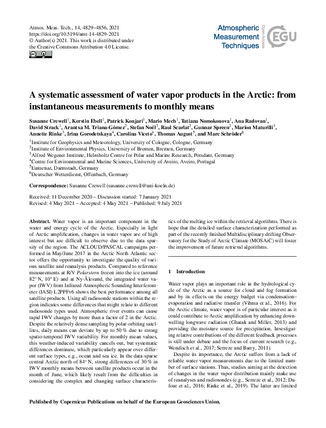Water vapor is an important component in the water and energy cycle of the Arctic. Especially in light of Arctic amplification, changes in water vapor are of high interest but are difficult to observe due to the data sparsity of the region. The ACLOUD/PASCAL campaigns performed in May/June 2017 in the Arctic North Atlantic sector offers the opportunity to investigate the quality of various satellite and reanalysis products. Compared to reference measurements at R/V Polarstern frozen into the ice (around 82∘ N, 10∘ E) and at Ny-Ålesund, the integrated water vapor (IWV) from Infrared Atmospheric Sounding Interferometer (IASI) L2PPFv6 shows the best performance among all satellite products. Using all radiosonde stations within the region indicates some differences that might relate to different radiosonde types used. Atmospheric river events can cause rapid IWV changes by more than a factor of 2 in the Arctic. Despite the relatively dense sampling by polar-orbiting satellites, daily means can deviate by up to 50 % due to strong spatio-temporal IWV variability. For monthly mean values, this weather-induced variability cancels out, but systematic differences dominate, which particularly appear over different surface types, e.g., ocean and sea ice. In the data-sparse central Arctic north of 84∘ N, strong differences of 30 % in IWV monthly means between satellite products occur in the month of June, which likely result from the difficulties in considering the complex and changing surface characteristics of the melting ice within the retrieval algorithms. There is hope that the detailed surface characterization performed as part of the recently finished Multidisciplinary drifting Observatory for the Study of Arctic Climate (MOSAiC) will foster the improvement of future retrieval algorithms.
Title
A systematic assessment of water vapor products in the Arctic: from instantaneous measurements to monthly means
Authors
Crewell, S., Ebell, K., Konjari, P., Mech, M., Nomokonova, T., Radovan, A., Strack, D., Triana-Gómez, A. M., Noël, S., Scarlat, R., Spreen, G., Maturilli, M., Rinke, A., Gorodetskaya, I., Viceto, C., August, T., and Schröder, M.
Published
by Atmospheric Measurement Techniques (AMT) at 2021-07-09
Abstract
